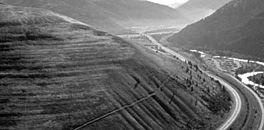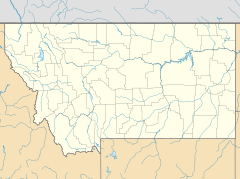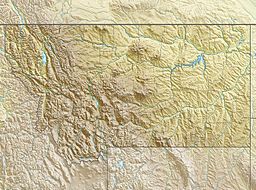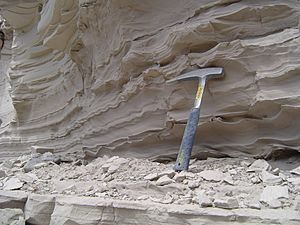Lake Missoula facts for kids
Quick facts for kids Lake Missoula |
|
|---|---|
| Location | Western Montana |
| Area | 7,770 km2 (3,000 sq mi) |
| Designated: | 1966 |
| Lake Missoula | |
|---|---|

Wave-cut strandlines cut into the slope at left in photo. These cuts record former high-water lines, or shorelines. Gullies above the highway are the result of modern-day erosion. (NPS Photo)
|
|
| Location | North America |
| Coordinates | 46°56′20″N 114°08′37″W / 46.93889°N 114.14361°W |
| Lake type | former lake |
| Primary inflows | Channeled Scablands |
| Primary outflows | Wallula Gap of the Columbia River |
| Basin countries | United States |
| Max. length | 200 mi (320 km) |
| Max. width | 57 mi (92 km) |
| Surface area | 7,700 km2 (2,973 sq mi) |
| Max. depth | 2,000 ft (610 m) |
| Water volume | 2,100 km3 (500 cu mi) |
| Residence time | 20 incidents |
| Surface elevation | 4,206 ft (1,282 m) |
Lake Missoula was a prehistoric proglacial lake in western Montana that existed periodically at the end of the last ice age between 15,000 and 13,000 years ago. The lake measured about 7,770 square kilometres (3,000 sq mi) and contained about 2,100 cubic kilometres (500 cu mi) of water, half the volume of Lake Michigan.
The Glacial Lake Missoula National Natural Landmark is located about 110 kilometres (68 mi) northwest of Missoula, Montana, at the north end of the Camas Prairie Valley, just east of Montana Highway 382 and Macfarlane Ranch. It was designated as a National Natural Landmark in 1966 because it contains the great ripples (often measuring 25 to 50 feet (7.6 to 15.2 m) high and 300 feet (91 m) long) that served as a strong supporting element for J Harlen Bretz's contention that Washington State's Channeled Scablands were formed by repeated cataclysmic floods over only about 2,000 years, rather than through the millions of years of erosion that had been previously assumed.
The lake was the result of an ice dam on the Clark Fork caused by the southern encroachment of a finger of the Cordilleran Ice Sheet into the Idaho Panhandle (at the present day location of Clark Fork, Idaho, at the east end of Lake Pend Oreille). The height of the ice dam typically approached 610 metres (2,000 ft), flooding the valleys of western Montana approximately 320 kilometres (200 mi) eastward. It was the largest ice-dammed lake known to have occurred.
The periodic rupturing of the ice dam resulted in the Missoula Floods – cataclysmic floods that swept across eastern Washington and down the Columbia River Gorge approximately 40 times during a 2,000 year period. The cumulative effect of the floods was to excavate 210 cubic kilometres (50 cu mi) of loess, sediment and basalt from the channeled scablands of eastern Washington and to transport it downstream. These floods are noteworthy for producing canyons and other large geologic features through cataclysms rather than through more typical gradual processes.
In addition, Middle and Early Pleistocene Missoula flood deposits have been documented to comprise parts of the glaciofluvial deposits, informally known as the Hanford formation that are found in parts of the Othello Channels, Columbia River Gorge, Channeled Scabland, Quincy Basin, Pasco Basin, and the Walla Walla Valley. The age of these deposits is demonstrated by the presence of multiple interglacial calcretes interbedded in these glaciofluvial deposits, sequences of sediments with normal and reverse magnetostratigraphy, optically stimulated luminescence dating, and unconformity truncated clastic dikes. Based upon these criteria, Quaternary geologists estimated that the oldest of the Pleistocene Missoula floods happened before 1.5 million years ago. The older Pleistocene glaciofluvial deposits within the Hanford formation are fragmentary in nature because they have been repeatedly eroded and largely removed by subsequent Missoula floods. Because of the fragmentary nature of older glaciofluvial deposits, the exact number of older Missoula floods, which are known as Ancient Cataclysmic Floods, that occurred during the Pleistocene cannot be estimated with any confidence. Although Lake Missoula likely was the source of many of the Ancient Cataclysmic Floods, the fragmentary nature of the older deposits within the Hanford formation makes precise determination of the precise origin of the floods that deposited them very difficult.
Contents
Geology
Ice dam on the Clark Fork River
The Cordilleran ice sheet originating in British Columbia expanded out of the mountains and southward. A tongue of ice pushed down the Purcell Valley or Purcell Trench, reaching south beyond Lake Pend Oreille. This Purcell Lobe blocked the natural outlet of the Clark Fork River. Including its tributaries, Clark Fork represented western Montana's most important river system. The ice mass that effectively dammed Clark Fork was about 2,000 feet (610 m) deep and extended for at least 10 miles some people say as much as 30 miles. The ice dam reached east up the Clark's Fork to Cabinet, Montana, about 10 metres (0.010 km) and southward around the mountain to Bayview, Idaho on the south tip of Lake Pend Oreille in Farragut State Park. Here, the ice sheet stood over 2,000 feet (610 m) and 25 miles (40 km) south of Lake Missoula.
Lake levels
The Clark Fork's drainage is a network of valleys among high mountain ranges. Lake Missoula formed through this region of western Montana. It is named for the Missoula in the upper reaches of the Clark Fork watershed. The mountains surrounding the city show the strandlines from the lake nearly 20,000 years ago. At its largest extent, Lake Missoula's depth exceeded 2,000 feet (610 m) and may have held 600 cu mi (2,500 km3) of water as much as Lake Erie and Lake Ontario combined. The surface area covered 3,000 sq mi (7,770 km2) and the shoreline attained an elevation of 4,200 feet (1,300 m).
The lake spread through the Clark Fork River basin, reaching east of Missoula, 259 miles (417 km) to Gold Creek; northeast up the Blackfoot River 270 miles (430 km) to Lake Alva; 253 miles (407 km) and east of Ovando 270 miles (430 km). Two large lobes formed to the south and north. To the south the Bitterroot Valley filled as far as Sula, Montana, 286 miles (460 km). To the north the Flathead River basin became an expansive body of water, creating an island of Red Sleep Mountain, now the National Bison Range and extending north 286 miles (460 km) to Polson at the basin of the Flathead Ice Lobe and 286 miles (460 km) up the Little Bitterroot River to Niarada some 132 miles (212 km) above the Flathead Rivers mouth at the Clarks Fork.
The water was deep (average - 800 feet (240 m)): maximum - 2,100 feet (640 m)), dark and murky with sediment. There is no evidence of fish. Scientists speculate that sediment known as rock flour created poor aquatic habitat. No evidence of large mammals, i.e.; mammoths, mastodons and bison may have roamed nearby, there is no evidence that these animals nor of human beings in the area. The Clark Fork River flows into Lake Pend Oreille at 2,062 feet (628 m).
Basins of Lake Missoula
| Reach | Riverway | Length | Max Depth | Outlet | Features |
|---|---|---|---|---|---|
| Clark Fork Canyon | Clark Fork River | 92 miles (148 km) from the ice dam at Lake Pend Orielle to Ninemile. | 2,150 feet (660 m) | Blocked at Lake Pend Orielle in Idaho. | Eddy Narrows, St. Regis Notch, Ninemile Rhythmites |
| Flathead River Basin | Flathead River | 71 miles (114 km) from the Clark Fork at Paradise to Polson, where the glacier stood | 1,665 feet (507 m) at Perma. | Joins the Clark Fork River at Paradise. | Ninepipes Pingo Scars, Paradise Center, National Bison Range, Sloan Bridge Sediments. |
| Little Bitterroot Valley | Little Bitterroot River | 43 miles (69 km) from the Flathead River to the glacial front near Niarada. | 1,363 feet (415 m) at Camas Prairie. | Joins the Clark Fork River near Ninepipe National Wildlife Refuge at Sloan Bridge and crossed the divide between the Clark Fork and the Little Bitterroot Rivers at Rainbow Lake. | Gulch Fill, Rainbow “Dog” Lake, Markle Pass Kolk, Camas Prairie Ripples |
| Missoula Basin | Clark Fork River | 37 miles (60 km) from Ninemile to Lolo | 1,176 feet (358 m) at Ninemile. | Enters the lower Clark Fork Canyon Reach at Ninemile. | Glacial erratic and Strandlines |
| Bitterroot Valley | Bitterroot River | 68 miles (109 km) from the Lolo in the Missoula Basin to near Sula. | 940 feet (290 m) at Lolo. | Enters to Missoula Basin at Lolo. | Features |
| Blackfoot River Valley | Blackfoot River | 57 miles (92 km) from the Bonner to Rainy Lake on the Clearwater River and 73 miles (117 km) up the Blackfoot River to near Helmsville. | 566 feet (173 m) at Potomac, Montana. | Joins the Clark Fork River. | Features |
| Upper Clark Fork | Clark Fork River | 55 miles (89 km) from the Bonner Flats to near Gold Creek on Interstate 90. | 1,197 feet (365 m) at Bonner. | Enter the Missoula Basin of the Clark Fork River west of Bonner. | Gold Creek High Water monument |
Clark Fork Canyon
This reach follows Montana Route 200 up the Clark Fork River canyon, 92 miles (148 km) to Paradise, then following the Clark Fork, then 49 miles (79 km) through the Paradise-St. Regis Canyon along Montana Route 135. At St. Regis, the canyon opens out and continues to the east 49 miles (79 km) with the river paralleled by Interstate 90 to along to Ninemile, where it opens out into the Missoula basin. A western branch of this basin runs up the St. Regis River another 32 miles (51 km) along with Interstate 90 to near Riverbend. Lookout Pass, 4,679 feet (1,426 m) asl along (I-90)
- Thompson Falls – Located in the northern or western reach of the basin, the modern river passes through a layer of harder rock, forming a cascade.
- Nine Mile Rhythmites – Located at the eastern end of the basin, near Nine Mile. A light pink sand and silt deposited on the bottom of the lake. The silt deposits exist where the basin was wide and when the lake drained, the area was not reached by the fast current of the water moving downstream. Each lay represents a period of still water behind the ice dam. The series reflects each period of still water with the intervening draining of the lake. Like a ‘varves’, darker layers a winter deposits, fine particles in quiet water and the lighter layers are courser particles from the more active summer currents. Here, the number of layers represent 1000 years of sediment.
Flathead Basin
The Flathead basin abutted the south face of the ice sheet. For most of this period, the glacial ice reached south to Polson, covering the entirety of Flathead Lake. The basin drains from the Polson Moraine at the south end of Flathead Lake, south to Ravalii with a major lobe up the Little Bitterroot River and a minor basin on Camas Creek near Perma.
-
- Little Money Creek Gulch Fill - Exit 96, north on US 93 to Ravalii. The coarse materials filling the side gulches on the narrow valley as Lake Missoula drained, these eddy currents in tributary gulches deposited debris.
- Rainbow ‘Dog’ Lake – Drains into the Clark Fork near Plains. During the existence of Lake Missoula, it was a drain for the Little Bitterroot basin when the lake level exceeded 3,620 feet (1,100 m) asl and for the Camas Prairie basin when the lake level exceeded 3,680 feet (1,120 m) asl. At the maximum depth of Lake Missoula, the valley was a 520 feet (160 m) waterway. Rainbow Lake is thought to be a cataract retreat lake, formed by a 100 feet (30 m) waterfall. The Clark Fork River dropped 1,700 feet (520 m) near Plains, creating a 60 to 70 miles per hour (97 to 113 km/h) current through Boyer Creek. A weaker layer of rock beneath a more resistant layer was removed, causing the lip of the falls to retreat backward. Evidence is provided by the debris that lines the valley bottom.
- Camas Prairie Mega ripples – Camas Prairie is a small basin on Camas Creek, north of Perma. At the maximum water levels of the Hwy 382 through the prairie to information sign at mile marker13. multiple long ridges of sediment, 25’ height and 100 feet (30 m) apart. Average height between 13 and 30 feet (4.0 and 9.1 m). Formed during the outflow of water during a break in the ice dam. The Camas Prairie Basin filled when Lake Missoula reached 2,770 feet (840 m) asl. As the water in the Lake Missoula Basin rose, this basin gained a second outlet through Rainbow Lake at 3,588 feet (1,094 m) asl; Willis Gulch 3,349 feet (1,021 m) asl; Markle Pass 3,352 feet (1,022 m) asl; Big Gulch 3,435 feet (1,047 m) asl.
- Markle Pass Kolks – Montana Highway travels through Markle Pass between Camas Prairie and the Little Bitterroot Valley. The Kolks were carved out of the bedrock by strong underwater vortices created as Lake Missoula quickly drained during the great floods. When the tornado like currents reached the bottom of the waterway, rocks were pulled out of the bottom surface. This debris can be found downstream towards Camas Prairie and Burgess Lake.
Missoula Basin
The basin extends from Missoula, west to Ninemile and up the Ninemile Creek valley. This 39 miles (63 km) long valley broadens from 5 miles (8.0 km) at Ninemile and to 10 miles (16 km) at Missoula. The central part of this basin around Missoula is 8 miles (13 km) wide E-W and 10 miles (16 km) N-S. The basin is bordered by Rattlesnake Ridge on the north and Petty Mountain on the south(west). Features: Strandlines along the valleys east flank.
- Glacial erratic on the grounds of the University of Montana.
- Strandlines can be seen on the slopes of both Mount Jumbo (4,764 feet (1,452 m) asl) and Mount Sentinel (5,081 feet (1,549 m) asl), east in the Missoula Valley. These lines represent lake levels as the Ice dam in the Purcell Trench failed and a lower lake level formed.
- Nine Mile Rhythmites on the bottom of the lake are visible.
Hamilton Basin
The basin southern tip in south of Conner to Lolo, 57 miles (92 km) to the north. The Bitterroot Mountains form the west shore and the Sapphire Mountains the east.
Blackfoot River Basin
The valleys of Potomac, Greenough, and Ovando-Helmville are linked by the Blackfoot River, east of Missoula. A second reach, up the Clearwater River joins the Blackfoot River at Clearwater. This basin joins the Clark Fork at Bonner. Upper valleys of the Clearwater-Blackfoot River basins, run 394 miles (634 km) from Seeley Lake, eastward to Brown's lake along Montana Route 83 and Montana Route 200.
Upper Clark Fork
The Clark Fork of the Columbia River, has its headwater near Butte, 130 miles (210 km) east of Missoula. Lake Missoula reached up the valley, about 55 miles (89 km) to east along I-90 to just east of Gold Creek. Smaller reaches formed along the tributary valleys of Gold Creek, 13.5 miles (21.7 km) up Flint Creek forming an 8 miles (13 km) wide basin, Lower Willow Creek, and 20 miles (32 km) up Rock Creek.
See also
 In Spanish: Lago Missoula para niños
In Spanish: Lago Missoula para niños




